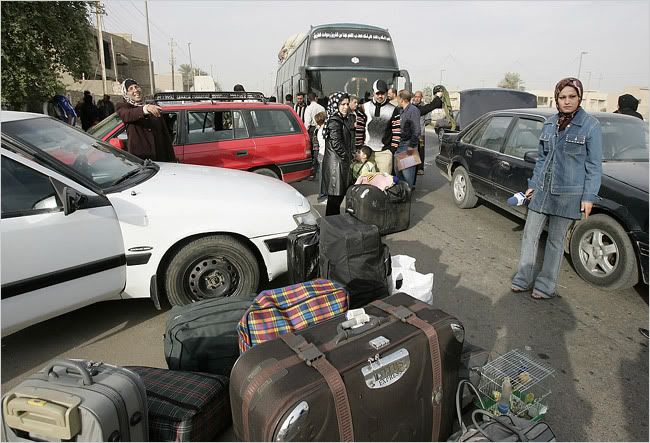 Iraqis who had gone to Syria to escape the violence at home arrived in Baghdad on Wednesday.
Iraqis who had gone to Syria to escape the violence at home arrived in Baghdad on Wednesday.
The NY Times reports:
At a row of travel agencies near the highway to Syria, the tide of migration has reversed: the buses and GMC Suburban vans filled with people heading to Damascus run infrequently, while those coming from the border appear every day.
By all accounts, Iraqi families who fled their homes in the past two years are returning to Baghdad.
The description of the scope of the return, however, appears to have been massaged by politics. Returnees have essentially become a currency of progress.
Under intense pressure to show results after months of political stalemate, the government has continued to publicize figures that exaggerate the movement back to Iraq and Iraqis’ confidence that the current lull in violence can be sustained.
On Nov. 7, Brig. Gen. Qassim al-Moussawi, the Iraqi spokesman for the American-Iraqi effort to pacify Baghdad, said that 46,030 people returned to Iraq from abroad in October because of the “improving security situation.”
Last week, Iraq’s minister of displacement and migration, Abdul-Samad Rahman Sultan, announced that 1,600 Iraqis were returning every day, which works out to a similar, or perhaps slightly larger, monthly total.
But in interviews, officials from the ministry acknowledged that the count covered all Iraqis crossing the border, not just returnees. “We didn’t ask them if they were displaced and neither did the Interior Ministry,” said Sattar Nowruz, a spokesman for the Ministry of Displacement and Migration.
As a result, the tally included Iraqi employees of The New York Times who had visited relatives in Syria but were not among the roughly two million Iraqis who have fled the country.
The figures apparently also included three people suspected of being insurgents arrested Saturday near Baquba in Diyala Province. The police described them as local residents who had fled temporarily to Syria, then returned.
Some Iraqi lawmakers said that overly broad figures were being used intentionally.
“They are using this number because they want to show that Maliki is succeeding,” said Salim Abdullah, a lawmaker and member of the largest Sunni bloc, known as the Accordance Front, referring to Prime Minister Nuri Kamal al-Maliki. “But this does not make the number correct. I think dozens of Iraqis return home daily, but not 1,600.”
A half-dozen owners of Iraqi travel agencies and drivers who regularly travel to Syria agreed that the numbers misrepresented reality.
They said that the flow of returnees peaked last month, with more than 50 families arriving daily from Syria at Baghdad’s main drop-off point. Since Nov. 1, they said, the numbers have declined, and on Sunday morning, during a period when several buses used to appear, only one came.
The travel agents said that they believed that Iraqis would continue to return to Baghdad from Syria and Jordan but that the initial rush appeared to be over.
A United Nations survey released last week, of 110 Iraqi families leaving Syria, also seemed to dispute the contentions of officials in Iraq that people are returning primarily because they feel safer.
The survey found that 46 percent were leaving because they could not afford to stay; 25 percent said they fell victim to a stricter Syrian visa policy; and only 14 percent said they were returning because they had heard about improved security.
Underscoring a widely held sense of hesitation, many of those who come back to Iraq do not return to their homes. Clambering off the bus on Sunday, a woman who gave her name as Um Dima, mother of Dima, said that friends were still warning her not to go back to her house in Dora, a violent neighborhood in south Baghdad. So for now, she said, she will move in with her parents in southern Iraq.
Raad al-Kihani, a prominent Shiite tribal leader in Baghdad and supporter of the prime minister, said that most people returning were still restricted by the fear of sectarian violence. “There are no Shiite families moving back to Sunni neighborhoods and no Sunnis moving back to Shiite neighborhoods,” he said.
The Iraqi government is using incentives and aggressive public relations to try to bring more people home. Iraqi officials plan to pay for buses to transport Iraqis from Syria. Prominent government figures recently visited Saab al-Bor, a largely abandoned town near Baghdad, to emphasize that families should feel safe enough to return.
The Displacement Ministry offers 1 million Iraqi dinar, about $800, to internally displaced families who can prove they have returned home with a letter from the police and their neighborhood council. But the movement has been limited. As of Thursday, 4,358 internally displaced families, about 25,000 people, had returned to their homes in Baghdad, the ministry’s registry of payments to returnees said.
Furthermore, people are still leaving their homes — 28,017 were internally displaced in October, according to the latest United Nations figures. In all, the United Nations estimates that 2.4 million Iraqis are still internally displaced, with many occupying someone else’s home.
Greater numbers will not return to their neighborhoods, some Iraqi lawmakers and independent migration specialists say, until a clear legal framework has been established to help them get their houses back without evicting other displaced families.
“The actions are slow and so many things needs to be done, said Ayaed al-Sammaraie, a member of Parliament and a leader of its largest Sunni Arab bloc. “The main thing people would like is to return to their spots, and it seems there isn’t a plan for that.”
Monday, November 26, 2007
Numbers of Iraqi Refugees Returning Home Exaggerated
Posted by Maeven at 11:17 AM
Labels: Another Bush cock-up, photos, refugees, Syria, war in Iraq